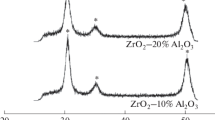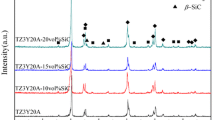The effect of Al2O3 weight content on the stability of the phase composition and strength of ceramic in the system Al2O3–3Y-ZrO2 prepared by a commercial technology was determined. It was shown that the introduction of aluminum oxide has a positive effect on the stability of the tetragonal phase of zirconium dioxide during accelerated aging. At the same time increasing the mass content of aluminum oxide from 15 to 80% does not significantly change the ratio t-ZrO2/m-ZrO2. It was observed that the strength of all materials containing aluminum oxide increases after aging for 5 h.



Similar content being viewed by others
References
P. M. Kelly and L. R. F. Rose, “The martensitic transformation in ceramics — its role in transformation toughening,” Progr. Mater. Sci., No. 47, 463 – 557 (2002).
N. Claussen, “Microstructural design of zirconia-toughened ceramics (ZTC),” Adv. Ceram., No. 12, 325 – 351 (1984).
R. C. Garvie, R. H. J. Hannink, and R. T. Pascoe, “Ceramic steel?,” Nature, No. 258, 703 – 704 (1975).
J. Chevalier, L. Gremillard, and S. Deville, “Low-temperature degradation of zirconia and implications for biomedical implants,” Ann. Rev. Mater. Res., No. 37, 1 – 32 (2007).
M. N. Rahaman, A. Yao, B. S. Bal, et al., “Ceramics for prosthetic hip and knee joint replacement,” J. Am. Ceram. Soc., 90(7), 1965 – 1988 (2007).
F. F. Lange, G. L. Dunlop, and B. I. Davis, “Degradation during aging of transformation toughened ZrO2–Y2O3 materials at 250°C,” J. Am. Ceram. Soc., 69(3), 237 – 240 (1986).
J. F. Li and R. Watanabe, “Influence of a small amount of Al2O3 addition on the transformation of Y2O3-partially stabilized ZrO2 during annealing,” J. Mater. Sci., 32(5), 1149 – 1153 (1997).
E. S. Elshazly, M. E. S. Ali, and S. M. El-Hout, “Alumina effect on the phase transformation of 3Y-TZP ceramics,” J. Mater. Sci. Technol., 24(6), 873 – 877 (2008).
S. Veselov, N. Belousova, N. Cherkasova, et al., “Development modes of prior free sintering to form a high-density fine grain ceramics after HIP,” Appl. Mechanics Mater., Trans. Tech. Publ., 698, 457 – 460 (2015).
N. Belousova, S. Veselov, R. Kuzmin, and E. Melnikova, “The influence of molding powder breakup on the sintered ceramic quality,” Appl. Mechanics Mater., 698, 513 – 518 (2015).
S. V. Veselov, “Evaluation of the effect of zirconium dioxide additive on the structure and properties of aluminum oxide ceramic,” in: Current Problems of Machine Engineering: Materials. International Scientific and Applications Conference [in Russian] (2014), pp. 473 – 477.
H. Toraya, M. Yoshimura, and S. Somiya, “Calibration curve for quantitative analysis of the monoclinic-tetragonal ZrO2 system by x-ray diffraction,” J. Am. Ceram. Soc., 67(6), 119 – 121 (1984).
C. J. Ho, H. C. Liu, and W. H. Tuan, “Effect of abrasive grinding on the strength of Y-TZP,” J. Europ. Ceram. Soc., 29(12), 2665 – 2669 (2009).
S.-L. Hwang and I.-W. Chen, “Grain size control of tetragonal zirconia polycrystals using the space charge concept,” J. Am. Ceram. Soc., 73(11), 3269 – 3277 (1990).
P. Li, I. W. Chen, and J. E. Penner Hahn, “Effect of dopants on zirconia stabilization — an x-ray absorption study: I, trivalent dopants,” J. Am. Ceram. Soc., 77(1), 118 – 128 (1994).
N. S. Stukacheva, S. V. Veselov, N. Yu. Cherkasova, et al., “Effectiveness of using nanodisperse zirconium dioxide powder to strengthen aluminum oxide ceramic,” Dokl. Akad. Nauk Vysshei Shkoly Ross. Feder., No. 4, 33 – 42 (2016).
M. Yoshimura, T. Noma, K. Kawabata, and S. Somiya, “Role of water on the degradation process of Y-TZP,” J. Mater. Sci. Lett., No. 6, 465 – 467 (1987).
J. Chevalier, L. Gremillard, A. V. Virkar, and D. R. Clarke, “The tetragonal – monoclinic transformation in zirconia: lessons learned and future trends,” J. Am. Ceram. Soc., 92, 1901 – 1920 (2009).
J. Schneider, S. Begand, R. Kriegel, et al., “Low temperature aging behavior of alumina toughened zirconia,” J. Am. Ceram. Soc., 91(11), 3613 – 3618 (2008).
H. Tsubakino, R. Nozato, and M. Hamamoto, “Effect of alumina addition on the tetragonal to monoclinic phase transformation in zirconia – 3 mol.% yttria,” J. Am. Ceram. Soc., 74(2), 440 – 443 (1991).
S. V. Veselov, N. S. Stukacheva, R. I. Kuz’min, et al., “Structure and mechanical properties of ceramic materials of the system Al2O3–ZrO2,” Nauch. Vest. Novosibirsk. Gos. Tekh. Univer., No. 4, 207 – 217 (2016).
F. Kern, S. Koummarasy, and R. Gadow, “The influence of stabilizer concentration on the mechanical properties of alumina – vol.% zirconia (0.6Y-2Y) composites,” J. Ceram. Sci. Technol., 7(3), 295 – 300 (2016).
Y. F. Yi, N. Wen, and X. L. Wang, “Comparison of the low temperature degradation properties of two Y-TZP ceramics for dental applications,” Key Eng. Mater., Trans. Tech. Publ., 492, 107 – 111 (2012).
C. Wang, L. M. Dong, Y. F. Yi, et al., “Influence of low temperature aging on the flexural strength of Y-TZP ceramics,” Key Eng. Mater., Trans. Tech. Publ., 512, 1756 – 1760 (2012).
This work was performed at Novosibirsk State Technical University with financial support from the Ministry of Education and Science of the Russian Federation as part of the implementation of a complex project on the development of high-tech industry (contract No. 02.G25.31.0144, December 1, 2015).
Author information
Authors and Affiliations
Corresponding authors
Additional information
Translated from Steklo i Keramika, No. 11, pp. 37 – 42, November, 2017.
Rights and permissions
About this article
Cite this article
Kuz’min, R.I., Veselov, S.V., Cherkasova, N.Y. et al. Change of the Phase Composition and Strength of Al2O3–ZrO2-Ceramic After Hydrothermal Aging. Glass Ceram 74, 415–419 (2018). https://doi.org/10.1007/s10717-018-0007-8
Published:
Issue Date:
DOI: https://doi.org/10.1007/s10717-018-0007-8




